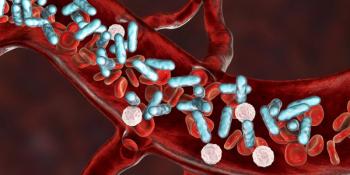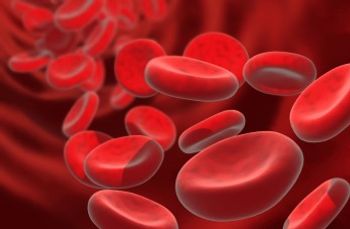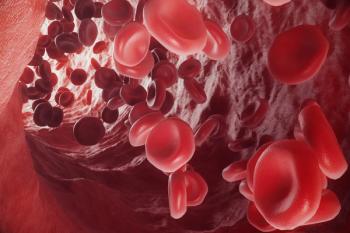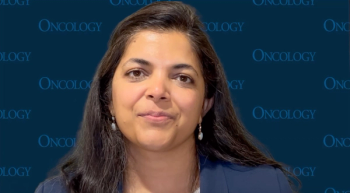
Weekly Carfilzomib Combination Shows MRD Negativity in Multiple Myeloma
The safety profile of carfilzomib, lenalidomide, and dexamethasone was tolerable in fit patients with newly diagnosed multiple myeloma.
Adding carfilzomib (Kyprolis) to lenalidomide (Revlimid) and dexamethasone (KRd) displayed high rates of minimal residual disease (MRD)-negativity in patients who are fit with newly diagnosed multiple myeloma vs lenalidomide/dexamethasone alone, according to results from the phase 3 EMN20 trial (NCT04096066) published in Lancet Haematology.
Efficacy data revealed that after a median follow-up of 35.2 months (IQR, 30.3-38.7), including a median 37.0 months (IQR, 32.8-42.5) in the carfilzomib-containing group and 31.1 months (IQR, 26.7-35.1) of the control group, the MRD-negativity rate per next generation sequencing at a sensitivity of 10-5 was 60% (95% CI, 43%-74%) vs 0% (95% CI, 0%-9%) at 2 years in the respective cohorts (P <.0001). Additionally, 27% vs 60% of each arm had discontinued treatment at the data cutoff date of March 29, 2024.
Furthermore, the median progression-free survival (PFS) was not reached (NR) in the KRd group vs 20.9 months (95% CI, 15.7-NR) in the control group. The respective 24- month rates were 83% (95% CI, 72%-95%) vs 49% (95% CI, 35%-68%) in the respective arms, and the investigational regimen significantly reduced the risk of progression or death as compared with the control regimen (HR, 0.24; 95% CI, 0.11-0.56; P =.00084). Additionally, the longer PFS outcomes associated with carfilzomib appeared to be consistent across subgroups according to cytogenic risk, disease stage, frailty, and age.
“To the best of our knowledge, this trial showed for the first-time high rates of MRD negativity with weekly [KRd] in patients who are fit or intermediate-fit with newly diagnosed multiple myeloma who [were] transplantation ineligible,” Sara Bringhen, MD, PhD, assistant professor in the Myeloma Unit of the Division of Haematology at the University of Turin in Turin Italy, and principal EMN20 trial investigator, wrote in the publication with study coauthors. “The exclusion of patients who are frail, weekly carfilzomib dosing, accurate monitoring of early signs or symptoms of cardiac dysfunction, and MRD-driven discontinuation of carfilzomib in patients with sustained MRD-negative status led to a generally manageable toxicity profile.”
Additional efficacy data revealed that the overall response rate (ORR) in the carfilzomib-containing group was 95% (95% CI, 84%-99%) vs 78% (95% CI, 62%-89%) in the control group (P = .024), with 93% (95% CI, 81%-99%) vs 48% (95% CI, 32%-64%) of the respective cohorts attaining at least a very good partial response (VGPR; P <.0001). A Kaplan-Meier estimate of 24-month overall survival (OS) was 88% (95% CI, 79%-98%) with the investigational regimen vs 76% (95% CI, 63%-91%) with the historical regimen, and OS was NR in either group at the time of data cutoff (HR, 0.41; 95% CI, 0.13-1.23; P = .11).
Between November 14, 2019, and November 23, 2021, 101 patients with newly diagnosed multiple myeloma were assessed for trial eligibility, with 82 patients enrolled. Those enrolled were randomly assigned 1:1 to receive KRd (n = 42) or lenalidomide/dexamethasone alone (n = 40). One patient in the latter cohort did not receive allocated treatment due to death related to disease progression.
Patients treated with carfilzomib received it intravenously at 20 mg/m2 on day 1 of cycle 1 and 56 mg/m2 on days 8 and 15 of cycle 1 of each 28-day cycle. For cycles 2 to 12, 56 mg/m2 was given on days 1, 8, and 15, and the same dose was given on days 1 and 15 of cycles 13 to 5 years after random assignment. Patients in this cohort who achieved at least a VGPR within a year of treatment and sustained MRD-negativity stopped carfilzomib 2 years after random assignment and continued with lenalidomide/dexamethasone until disease progression or intolerance.
Both cohorts received 25 mg of oral lenalidomide given on days 1 to 21 and oral dexamethasone at 40 mg on days 1, 8, 15, and 22 of 28-day cycles until disease progression or intolerance. In patients 75 years and older, dexamethasone was given at a starting dose of 20 mg.
The median age in the investigational and control cohorts was 73.0 years (IQR, 70.3-75.8) vs 74.0 years (IQR, 72.0-76.3), with 48% vs 55% between 71 and 75 years old. Most patients were male (60% vs 55%), had International Staging System (ISS) stage II disease (40% vs 45%), revised ISS stage II disease (60% vs 79%), and an ECOG performance status of 0 (52% vs 60%). In each cohort, those treated most had a Charlson Comorbidity Index of 0 (67% vs 60%), a fit frailty score (62% vs 55%), and a standard risk cytogenetic profile (78% vs 78%).
The coprimary end points were MRD negativity and PFS. Secondary end points included ORR, disease progression or death after second line of therapy, duration of response, OS, quality of life, and toxicities.
The most frequent grade 3 or higher treatment-emergent adverse effects (TEAEs) in the carfilzomib and control arms included neutropenia (22% vs 15%), thrombocytopenia (10% vs 2%), diarrhea (10% vs 0%), infections (7% vs 0%), cardiac disorders (7% vs 2%), and skin rash (2% vs 10%). Serious AEs were observed in 37% vs 40% of the respective arms, and secondary primary malignancies were reported in 4% of the control group. TEAEs leading to death occurred in 2 patients in the carfilzomib group––both due to SARS-CoV2 infections––and 4 patients in the lenalidomide/dexamethasone group, which included individual instances of acute myocardial infarction, cardiac failure, septic shock, and SARS-CoV2 infection.
Reference
Bringhen S, Cani L, Antonioli E, et al. Carfilzomib–lenalidomide–dexamethasone versus lenalidomide–dexamethasone in patients with newly diagnosed myeloma ineligible for autologous stem-cell transplantation (EMN20): a randomised, open-label, multicentre, phase 3 trial. Lancet Haematol. 2025;12(8):e621-e634. doi:10.1016/S2352-3026(25)00162-0
Newsletter
Stay up to date on recent advances in the multidisciplinary approach to cancer.

















































































